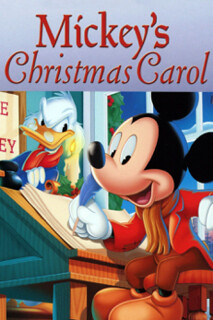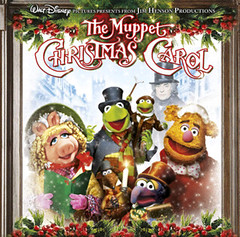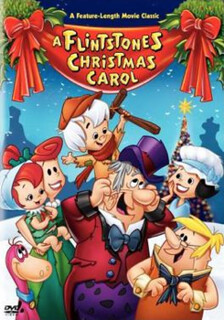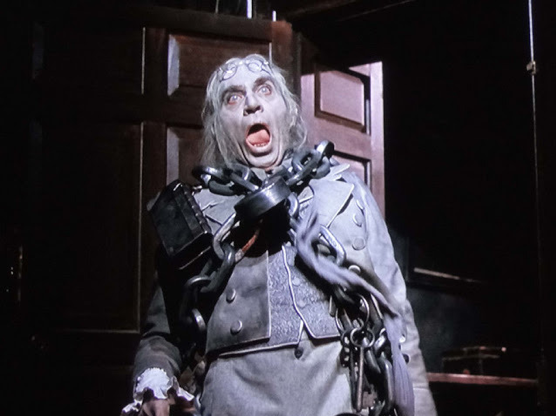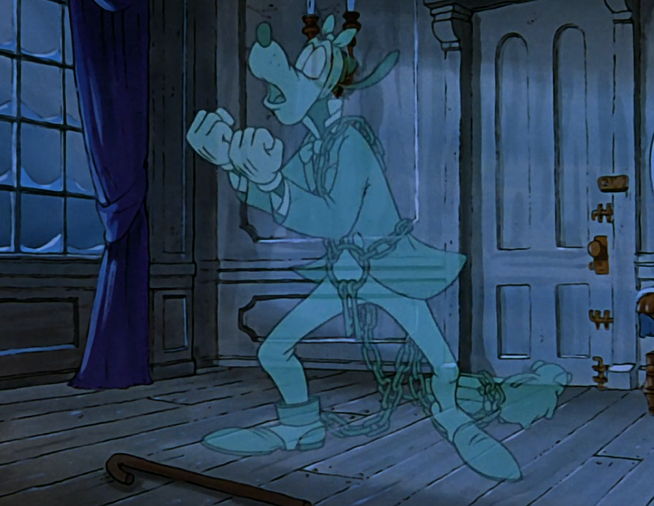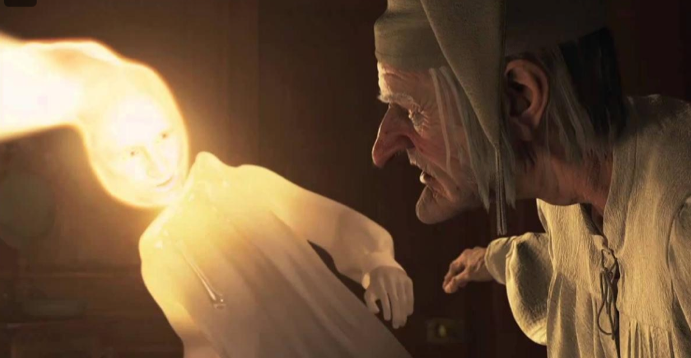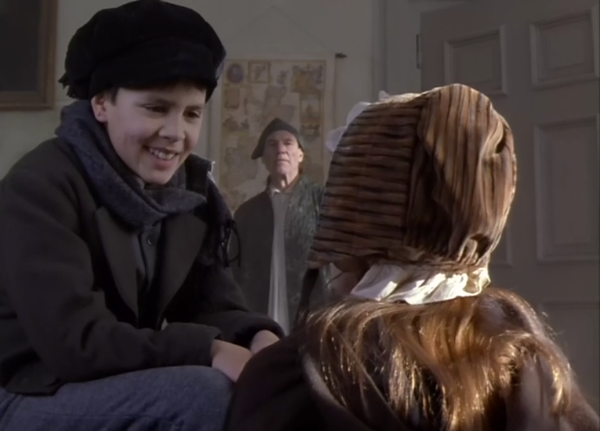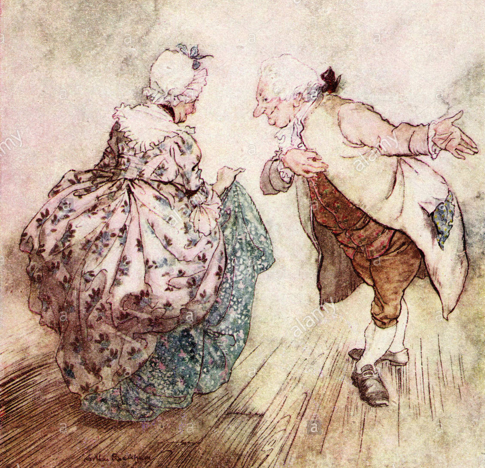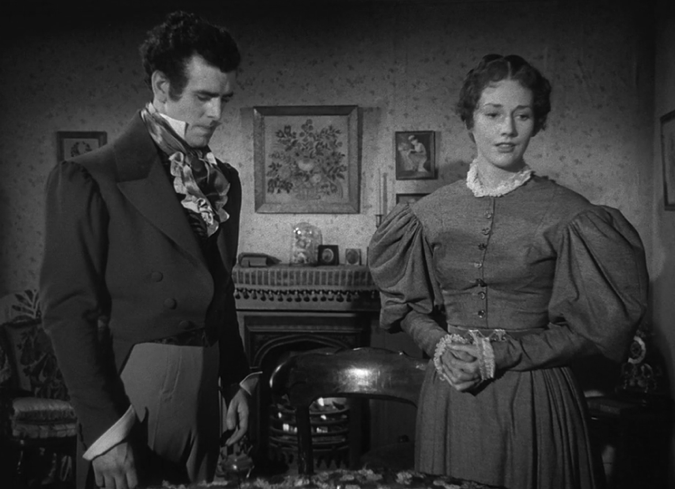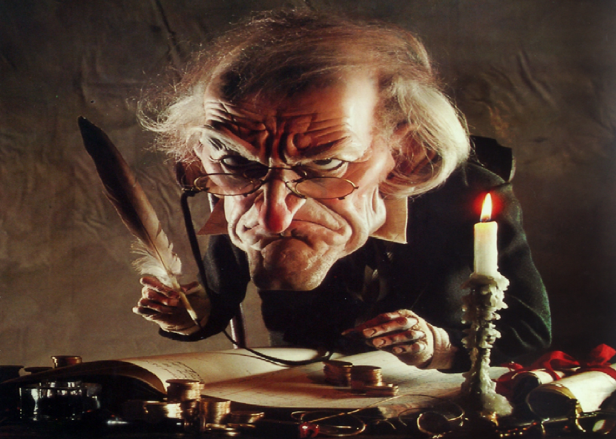FEATURES|COLUMNS|Art of Living
Using A Christmas Carol to Clarify Your Core Values
When the famous Russian novelist Leo Tolstoy died, he asked to be buried in the very spot on his family estate where, playing in the forest as a child, his older brother had thrown a stick that, according to him, had the secret to everlasting happiness engraved on the back.
Long before Nelson Mandela became the first non-white president of South Africa, it had become clear to him how crucial it was to have a core principle — in his case equal rights for all, regardless of race, creed or gender —in relation to which everything else was just tactics.
As a teenager, Elon Musk crafted a single-sentence mission statement that has arguably guided his behaviour ever since: “Really, the only thing that makes sense is to strive for greater collective enlightenment.”
All three, have or had a core value or aim in life, but how do we go about clarifying the sorts of principles that can guide us?
What if Charles Dickens’ famous novella A Christmas Carol (1843) can help?
Wait.
I know what you’re probably thinking . . . Bah humbug! A Christmas Carol is a saccharine, played-out period piece full of sentimental caricatures, exaggerated contrasts, and a Hollywood character arc. Plus, all those money-diving Scrooge McDucks and Muppet Jacob Marleys have long since ruined whatever value the original tale may have once had.
Or maybe not.
Maybe, like me, you’ve loved the story since you were a kid for these exact same reasons.
Whatever the case may be, this much seems clear: when we strip away all of the cultural accretions and get right down to the story itself, what we find is an unabashedly sentimental but at times an almost unbearably intense and brutally compassionate guide to personal transformation. In fact, several scholars and literary critics have suggested that the novella anticipates the invention of psychoanalysis by over fifty years*. After all, to change his behavior, Scrooge has to gain insight into the repressed childhood origins of his current behavior. And to do this, he needs professional guidance, not just from Jacob Marley but from the three spirits who, like any shrinks worth their salt, force him to do a thorough life review and restructure.
But it’s not just the psychoanalytic process that the story anticipates: as we will see, it also anticipates many of the core techniques we find in current psychotherapeutic and spiritual modalities like Acceptance and Commitment Therapy, Internal Family Systems Therapy, Compassion Focused Therapy, and aspects of Thich Nhat Hahn’s strand of Zen Buddhism, and others.
Imagining Your Own Personal Jacob Marley
As you may remember, Dickens begins A Christmas Carol by stating very bluntly that “Marley was dead” and, more specifically, that Marley was “dead as a doornail.” Jacob Marley is Scrooge’s deceased business partner and although a number of important events occur before his ghost makes an appearance, the story doesn’t really kick off until it does.
Jacob Marley is a vivid manifestation of Scrooge’s almost-certain future. He is Scrooge’s dysfunctional twin, his worst self, what Scrooge knows will become of him if all the struggles that dominate his life continue.
In life, Scrooge and Marley were nearly identical. Although Marley died seven years to the day before the story begins, Scrooge still hasn’t taken down the sign out front that reads “Scrooge and Marley.” Nor does he balk at answering to Marley’s name. The two are “kindred spirits.”
Marley’s ghost is draped in heavy chains adorned with cashboxes, keys, padlocks, ledgers, deeds, and steal purses. When Scrooge asks him why he wears it, Marley says, “I wear the chain I forged in life. I made it link by link, and yard by yard.” These are the chains of karma, habitual action, and more specifically of greedy and selfish action. Marley valued money and himself while he was alive, and he is what will become of Scrooge if Scrooge realizes too late that his life is not what he wanted it to be about. Marley’s occasional shrieks of agony erupt out of the gap between where he is and where he wishes he was. They are the sound of his failure to live in alignment with his core values.
The Jacob Marley Exercise: Who’s your Jacob Marley? We all have one, a mom or dad, a friend or frenemy, an actor or avatar who is the physical embodiment of our own dreaded future self. What does your dysfunctional twin look and sound like? Are there cash boxes and steal purses nestled amidst its chains or cell phones and car keys? If you’re having a hard time, recall the triggers that prompt you to armor up, puff out, or play small in your daily life? If you, like Scrooge, continue to let them trigger you, what do you imagine you and your life will look like in another five or ten or twenty years?
Do What the Spirit Says Do
According to the story, one of the upsides of vividly imagining your own worst self is that it can prompt you to identify with another sense of self that Dickens personifies as three time-travelling dream-ghosts or what he calls “spirits.” Each of the spirits of Christmas Past, Present, and Future is characterized differently, but they share these qualities: they are spirits; they are agents of psychological liberation; they are unbounded by space or time; they help Scrooge view key incidents in his life from a detached but benevolent vantage-point.
You don’t have to be religious, let alone Christian, to gain access to an invisible and impalpable sense of self from which you can simply observe with curiosity and compassion, the memories, fantasies, feelings, and thoughts that whelm up in your mind. In the mindfulness-based psychotherapeutic approach known as ACT (Acceptance and Commitment Therapy), for instance, this sense of self is generally referred to as the “observing self”, a sense of self that is “boundless,” “not experienced fully as a thing,” and that is “critical to psychological health.” It’s also worth noting that virtually every wisdom tradition in the world has some variant of it: observing ego, mindful witness, holy spirit, atman, clear light. Call it what you will, it is this sense of self that is summoned by Scrooge’s worst self for the sake of his “welfare” and “reclamation.” With this mission in mind, the first of the spirit transports Scrooge to a “long, long forgotten” scene from when he was ten or twelve and his capricious father had cruelly abandoned him for at least a year and forced him to spend at least one particularly painful and lonely Christmas eve at a run-down boarding school.
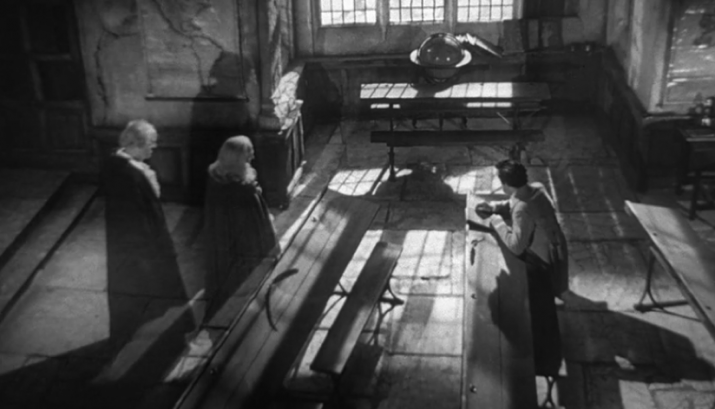 Brian Hurst’s Scrooge (1951). From imdb.com
Brian Hurst’s Scrooge (1951). From imdb.comWhat Scrooge basically needs to do with the most painful memory of his childhood is almost captured in the old line, “Don’t just do something – stand there!” Almost. Because in addition to just standing there, vividly remembering and actively reliving each minute detail and nuance of his most difficult childhood memory from the perspective of his observing self, Scrooge must do one other small thing: he must allow himself to be moved to self-compassion by what he sees.
And he does.
Mainly because, before bringing him to this scene, the spirit does something crucial: “Bear but a touch of my hand there,’ said the Spirit, laying it upon his heart.” With the help of the spirit of self-compassion the spirit itself has summoned, Scrooge is able to “weep” when he sees his “solitary” and “neglected” boyhood self and then, near the end of the scene, weep again: “he said, in pity for his former self, ‘poor boy,’ and cried again.”
The spirit’s message seems pretty unambiguous: before Scrooge can get clear on what it is that he wants his life to be about, he must first revisit and then summon self-compassion for the long forgotten self that is still, after all these years, frozen inside him, floating in a timeless state of suspended animation.* And this process that Scrooge goes through is strikingly similar to the same basic processes that we find in the many depth-oriented self-compassion exercises in Internal Family Systems (IFS) as well as several of the key self-compassion exercises formulated by Kristin Neff and Chris Germer, as well as some of the self-compassion techniques utilized in Acceptance Commitment Therapy (e.g. Contacting the Many Different Selves”). In all of these modalities, we also often find the same basic sentiment we find conveyed by A Christmas Carol: before we can feel compassion for others, we often have to start with generating compassion for ourselves. Dickens understood this well: the instant Scrooge experiences genuine kindness toward his wounded boyhood self, he immediately feels and expresses healthy remorse for his cruelty toward the boy who, earlier that morning, came to the door to sing a Christmas carol.
The Ghost of Christmas Past Exercise: To uncover the barriers that may be blocking your core values, identify with your observing self and then recall with curiosity and self-compassion a moment (or moments) of difficulty from your earliest life that may have caused you to armor up and, in the process, wall off your most deeply-held values.
The Fan and Fezziwig Exercises
As uncomfortable as it is for Scrooge to relive this difficult episode from his childhood, it simultaneously puts him in touch with several of his childhood “heroes” that help him clarify his own most deeply-held values.
The first of these is his loving and large-hearted little sister Fan whose repeated efforts finally free him, at least physically, from the prison of his childhood isolation. What he admires most about her is her capacity to do what he himself, until recently, has railed against doing: helping children in need. Yet, ironically, Scrooge’s childhood hero bears the exact same quality he himself glimpses inside his childhood pain: his purpose, and more specifically the desire, to help children who are as vulnerable as he himself was as a boy.
But the hero that Dickens spends the most time on is Scrooge’s first boss, Fezziwig.
What Scrooge admires the most about Fezziwig is how generous, vital, inclusive, and sociable he is. He adores his wife, dances with great gusto, and treats his employees with such respect and kindness that they will do anything for him. And once again, Scrooge doesn’t just dryly recollect this scene. No, the Spirit remarks that Scrooge’s “heart and soul were in the scene” and emphasizes that Scrooge “corroborated everything, remembered everything, enjoyed everything, and underwent the strangest agitation.” And by pointing out the obvious discrepancies between how Scrooge and Scrooge’s adolescent hero behave in life and work, Scrooge is once again moved to compassion.
The Fan and Fezziwig Exercise: Who were your childhood heroes? Consider the people who played a direct role in your life: family members, friends, teachers, coaches, teammates, bosses and so on. Who was your Fan? Who was your Fezziwig? What qualities — not circumstances, but personal qualities — did you most admire about them? How are you like or unlike them? What if the things that you most admire about them are also the values you yourself hold most dear? You might also do the same exercise with people who have inspired you indirectly (as Scrooge does when he recalls the role that fictional characters like Ali Baba and Robinson Crusoe played in his early life). What authors, artists, athletes, celebrities, superheroes, or TV characters did you look up to? What personal qualities of theirs did you admire most?
Scrooge’s Life Sentence
In the next scene, after this brief respite, the spirit forces (literally forces) Scrooge to witness a scene that sums up and encapsulates his protective and extremely costly response to the difficult events of his childhood. It is a bit later in Scrooge’s life and his adorable fiancé Belle is breaking off their engagement because it is as clear as a bell to Belle that Scrooge has come to value financial security more than he will ever value her.
Over the course of a couple years, she has watched all of his “nobler aspirations fall off one by one” until only his “master passion” remains: materialism. She also understands all too well that what fuels the fire of his greed is his fear that poverty will recapitulate his boyhood experience of abandonment and neglect. “All your other hopes have merged into the hope of being beyond the chance of its [poverty’s] sordid reproach,” she observes. And then, for good measure, she adds, “You fear the world too much.”
In a way, Belle is implying that Scrooge has become imprisoned behind the bars of a life sentence that sounds something like this: “If I can get rich enough, I’ll never be abandoned or neglected again.” There are different names from different modalities for this aspect of Scrooge’s behavior — defense mechanism, experiential avoidance, schema coping behavior, protector, story, life sentence — all different metaphors for the same basic phenomenon: when we are unwilling to simply experience the unwanted emotions associated with difficult experiences, we tend to protect ourselves from them in ways that, later in life, wind up amplifying the pain.
The Life Sentence Exercise: What life sentence have you been serving, if any, as a result of your instinctive attempt to protect yourself from whatever moments of difficulty you may have experienced in your early life? Here are some of the classics (adapted from Jeffrey Young’s Schema Therapy): not enough, can’t trust, don’t matter, on my own, don’t fit in, can’t do it, unwanted, unlovable, special, etc.
The Costs of Your Life Sentence
As a mercenary investor and consummate miser, you’d think Scrooge would be particularly attuned to the costs of buying into his life sentence. But he isn’t. Which is why the three spirits have to spend so much of the story making it clear to Scrooge just how expensive his defenses have been.
First and foremost, as we have seen, they cost him his relationship with his fiancé Belle, the memory of which “tortures” Scrooge. But apparently the mere memory of their break-up doesn’t torture him enough because the spirit insists on transporting him to an idyllic scene inside Bell’s house in the present where, with convincing accuracy, Scrooge imagines just how wonderfully her life has turned out. As painful as it is for him to see the loving husband and perfect family in this unlived life, it is the sight of Belle’s daughter that stings the most: “and when he thought that such another creature, quite as graceful and as full of promise, might have called him father, and been a springtime in the haggard winter of his life, his sight grew very dim indeed.”
The Spirit also takes Scrooge to a joy-filled market full of people buying groceries for Christmas dinner, to a celebration in a miner’s cottage, and another in a lighthouse, where hegets glimpses of anonymous people who, despite their poor, remote, and isolated conditions, have the ability to truly rejoice in life together. Unlike him. Each scene drives it further into Scrooge’s heart what a pathetically isolated life he has come to live as a result of his attempts to protect himself.
Tallying Up the Costs Exercise: What has your own life sentence cost you? Just how expensive has it been? Add up the costs. Have you suffered enough?
Attending Your Own Funeral
Even after Scrooge has faced the wrath of the math, he’s still not quite ready to spring his trap. First, he must go through a final, harrowing experience that has since been adopted (without credit) in run-away best-sellers ranging from The Seven Habits of Highly Effective People (1989), What Color is Your Parachute? (1970), and Get Out of Your Mind and Into Your Life (2005).
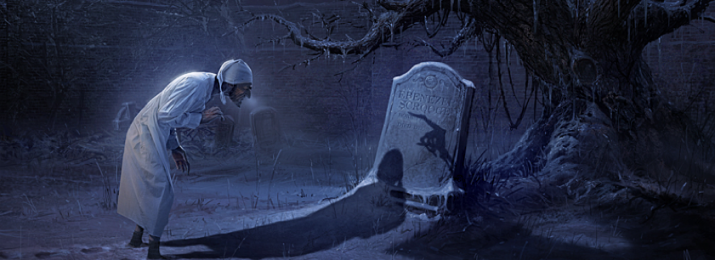 Robert Zemeckis’ A Christmas Carol (2009). From imdb.com
Robert Zemeckis’ A Christmas Carol (2009). From imdb.comAs you probably remember, Scrooge must experience a direct and almost unbearably visceral encounter with how others will respond to his death. In the aftermath of his own death, he must witness the callous indifference of the wealthy businessmen he has gone out of his way to curry favor with; he must watch one of his servants strip the very shirt from his dead body to sell to a pawnbroker; and he must stand by, powerlessly, as he hears the “sound of gnawing rats” coming from the same room as his “plundered and bereft, unwatched, unwept, uncared for” corpse. Finally, when he asks “if there is any person in the town, who feels emotion caused by this man’s death” all the spirit can show him is a relieved and happy couple whose debts will be delayed (but not forgiven) because he has died.
It is only after Scrooge has awoken from this redemptive nightmare that he is finally prepared to cast off his willful, selfish miserliness and live in line with the values that have been smouldering inside him since he was a child:generosity, benevolence and sociability. After making a large donation to the charity he rejected the day before, he sends a big turkey to the Cratchits for Christmas, spends the afternoon with Fred’s family, gives Bob Cratchit a raise, and becomes a father figure to Tiny Tim. As Irving Yalom observes in his book Staring at the Sun (2008), “Though the physicality of death destroys us, the idea of death may save us.”
Sound too good to be true?
Consider the following anecdote about Alfred Nobel, who founded the famous Nobel Prize. When he was travelling in later life, Alfred’s brother died, but some reporters mistakenly thought it was he who had died and began publishing obituaries about him. This put Alfred in the unique position of witnessing, like Scrooge, how people would respond to his death. The experience made Alfred Nobel realize two things: first, he was going to be remembered as the person who had invented dynamite and therefore made it possible to kill more people than any other person in history up to that point; second, he didn’t want to be remember like that. And it was this second realization that prompted him to establish the Nobel Prize that he is now remembered for.
The Ebenezer Scrooge Exercises
To clarify your core values and live in alignment with them, follow these simple steps:
- 1. Conjure up a vivid vision of a dysfunctional twin who symbolizes what you and your life will look like if the things that trigger you in your daily life continue to do so, or grow worse.
- 2. Access your observing self and, from this vantage-point, compassionately witness any incidents of early adversity that may have caused you to wall-off your core values;
- 3. Recall your childhood heroes and clarify what you most admire about them;
- 4. Get clear on what life sentences you may be serving to protect yourself from any adverse events in your early life;
- 5. Honestly acknowledge the negative impacts that your life sentences have had on yourself and others;
- 6. Imagine how people will likely respond to your death if you continue to serve your life sentence;
- 7. Get clear on how you would like people to respond to your death and then act in alignment with those values.
* See: Shainess, N. 1992. "Charles Dickens: The first (interpersonal) psychoanalyst or—a christmas carol: A literary psychoanalysis." American Journal of Psychoanalysis. 52(4): 351-362, and Barecca, R. 2011. "Introduction." In A Christmas Carol and Other Stories by Charles Dickens. Penguin Books: London
** While this might sound like very psychoanalytic in nature, it’s worth noting that the Vietnamese Zen Buddhist Thich Nhat Hahn recommends something very similar in his book Reconciliation:
Sometimes the wounded child in us needs all our attention. That little child might emerge from the depth of your consciousness and ask you for your attention. If you are mindful, you will hear her or his voice calling for help. At that moment, instead of paying attention to whatever is in front of you, go back and tenderly embrace the wounded child. You can talk directly to the child with the language of love, saying, "In the past I left you alone; I went away from you. Now I’m very sorry, I’m going to embrace you." You can say, "Darling I’m here for you. I will take good care of you. I know that you suffer so much. I’ve been so busy. I’ve neglected you and now I’ve learned a way to come back to you." If necessary, you have to cry together with that child.
Related features from Buddhistdoor Global
How to Want What You Already Have: A Practice for Taking Life As Granted Rather than For Granted
Navigating the Treachery of Images, Lessons from René Magritte
Literature as a Way of Living, Part One
Literature as a Way of Living, Part Two
A Time of Giving: A Christmas Meditation on Generosity for Buddhists
Buddhistdoor View: Renewing the Joy of Encountering the Other This Festive Season

